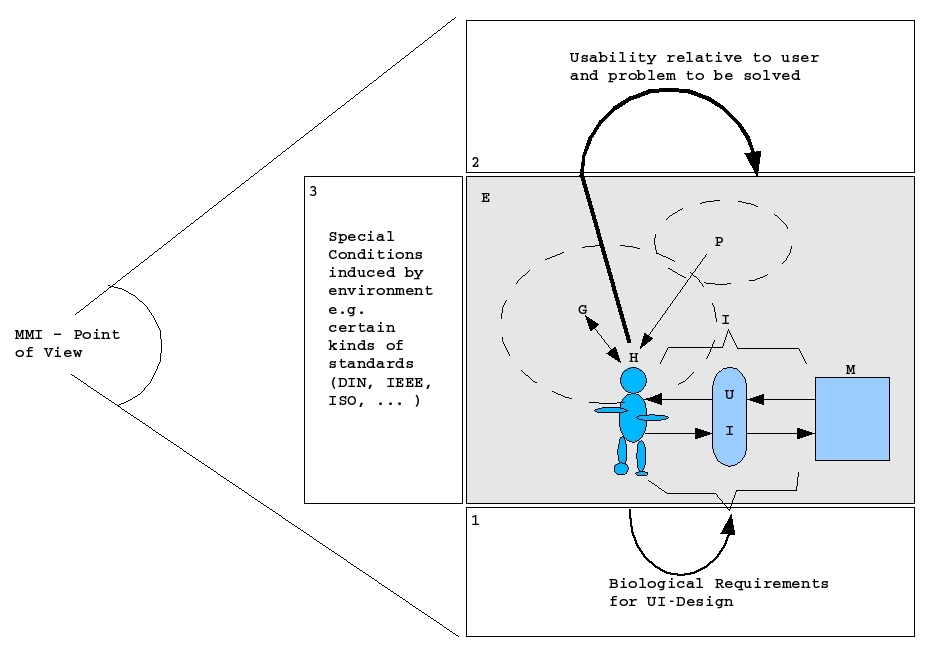
HMI/MMI/HCI
|
From a historical point of view one can embed the task of human machine interaction sciences within the bigger framework of human evolution (cf. figure).:
| Figure: Co-Evolution of Human Information Processing and Real world Environment |
The human body and information processing capabilities have been developed through about 3.5 Billion years. One of the main design results is the enabling of a human system which can cope with the challenges of its environments. Therefore we can state today that there is an astonishing coupling of real world conditions and human body properties capable of 'surviving' under these real conditions. The main medium for the 'shaping' of the working structures of the human body is the population which enables genetic production within re-production, which enables growing as well as learning.
For more details see e.g.: Bowler, B. J. (1989); Deacon, T. W. (1997); Eibl-Eibesfeldt, I. (1980); Hauser, M. D. (1996); Küppers, B. - O. (1990); Ward, P. D., & Brownlee, D. (2000).
With the recently advent of technical systems called 'machines' the situation has changed a little bit. These machines are not co-evolved with the real biological capabilities of human persons; they have been constructed out of partial knowledge about world and biological live. In the beginning they were usually badly adapted to the real world interaction interface of human persons. Only very recently gained the technology some maturity which allows a better adaptation to the biological interface of human persons. And because technical systems are invading today more and more the daily environment of people, are becoming part of the local living space, is the necessity growing to adapt these machines to the real properties of human persons to minimize failures, damages, and all kinds of negative impact on human persons.
| Figure: Main Requirements for Human Machine Interfaces |
The ideal Human Machine Interface is similar enough to the usual way how human persons are interacting with their real environment and that their demand on human capabilities is safely within the available biological limits. The usual case today is that the Human Machine interfaces are still badly adapted and that they are usually not within the biological limits. This will become evident when we will consider for instance the today interfaces with regard to their challenges of human memory. Human memory is a central resource of human information processing and most machine interfaces are badly adapted to the memory capabilities of people, especially young and elderly people.
Turning from the historical perspective to the
special domain of interest of Human Machine Interactions we would
describe the main tasks of the sciences of HMI as follows (cf. the following
figure):
 |
| Figure:
MMI -
Domain of Investigations |
(i) Being able to evaluate machines with regard to the intended users, whether the machines are 'usable' for the intended applications of the user.
To be able to make such evaluations one needs as point of reference the 'ideal values' describing the capabilities of the user. Therefore:
(ii) Describe the biological
(and psychological) limits within
every
kind of MMI has to be placed. Because the human system is a dynamic
system with characteristic growth processes, including aging, as well
as typical kinds of limitations, one has to consider important
'subgroups' characterized by special sets of properties.
In todays societies there exist a lot of important cultural, political, social etc. 'norms' and 'standards' which have to be obeyed during actions. Therefore:
(iii) Explain or certify whether and how certain valid norms/
standards are
fulfilled by
a certain user interface
What is not a genuine task of MMI is the
design and
construction of a concrete user interface (UI). This belongs to
software engineering (SWE), which is a discipline on its own. MMI can
(and should) support SWE to build 'good' user interfaces.
One has also to distinguish between the general
conditions which
have to be examined by MMI and the special conditions. The
general conditions are part of every kind of user interface. The
special conditions are due to special application scenarios. But
because every concrete User interface is designed to service in the
solution of certain problems as part of some social
reality
(a working group, a department, a company,....) one has to
consider
also these contexts. But because these context vary enormously one can
only select some examples to illustrate by them some general principles.